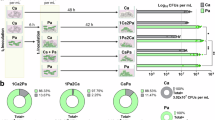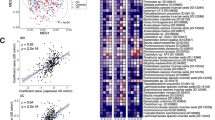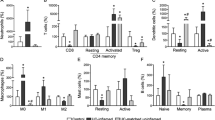Abstract
Isolates of C. ulmi from Britain fall into two groups on the basis of cultural characters. Pathogenicity experiments show one group to be aggressive and the other to be non-aggressive. Some North American isolates resemble the aggressive isolates, while isolates from Northern Europe are non-aggressive.
This is a preview of subscription content, access via your institution
Access options
Subscribe to this journal
Receive 51 print issues and online access
$199.00 per year
only $3.90 per issue
Buy this article
- Purchase on SpringerLink
- Instant access to full article PDF
Prices may be subject to local taxes which are calculated during checkout
Similar content being viewed by others
References
Gibbs, J. N., and Howell, R. S., Forest Rec., Lond., 82 (1972).
Gibbs, J. N., Heybroek, H. M., and Holmes, F. W., Nature, 236, 121 (1972).
Peace, T. R., Bull. For. Comm., Lond., No. 33 (1960).
Went, J. C., Tijdschr. PlZiekt., 60, 109 (1954).
Walter, J. M., J. Agric. Res., 54, 509 (1937).
Schwarz, M. B., Med. Phytopath. Lab. Willie Commelin Scholten, No. 5 (1922).
Wollenweber, H. W., and Stapp, C., Arb. Biol. Bund Anst. Land-u. Forstw. 16, 383 (1928).
Author information
Authors and Affiliations
Rights and permissions
About this article
Cite this article
GIBBS, J., BRASIER, C. Correlation between Cultural Characters and Pathogenicity in Ceratocystis ulmi from Britain, Europe and America. Nature 241, 381–383 (1973). https://doi.org/10.1038/241381a0
Received:
Issue date:
DOI: https://doi.org/10.1038/241381a0
This article is cited by
-
Complexities underlying the breeding and deployment of Dutch elm disease resistant elms
New Forests (2023)
-
Hybridization and introgression drive genome evolution of Dutch elm disease pathogens
Nature Ecology & Evolution (2020)
-
Host selection behavior and incidence of the bark beetle Scolytus kashmirensis (Coleoptera: Curculionidae: Scolytinae) attacking elm (Ulmus spp.) trees in Kashmir
Forestry Studies in China (2012)
-
A comparison of the nucleotide sequence of the cerato-ulmin gene and the rDNA ITS between aggressive and non-aggressive isolates ofOphiostoma ulmi sensu lato, the causal agent of Dutch elm disease
Current Genetics (1996)
-
Inheritance of chromosome-length polymorphisms in Ophiostoma ulmi (sensu lato)
Current Genetics (1995)



